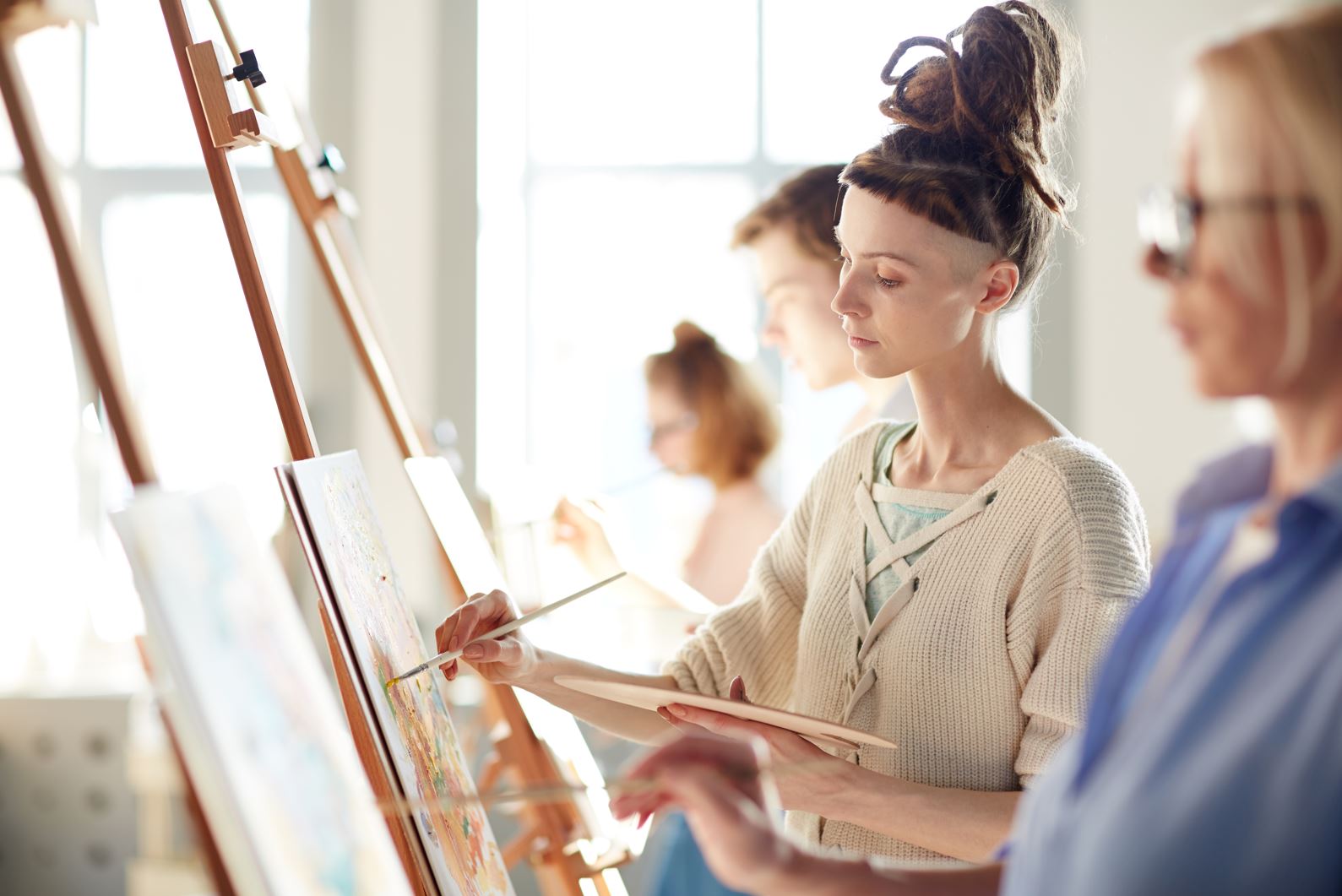Starting painting as a creative hobby can be a rewarding and enjoyable experience. Whether you’re a complete beginner or have some artistic background, here are some steps to help you get started:
1. Gather Supplies: Before you start painting, you’ll need some basic art supplies. Consider purchasing acrylic or watercolor paints, paintbrushes of different sizes and shapes, a palette for mixing colors, watercolor paper or canvas, and a container for water if you’re using watercolors.
2. Choose Your Medium: Decide which painting medium interests you the most. Acrylic and watercolor are great options for beginners due to their ease of use and versatility. Acrylic dries quickly and is forgiving, while watercolors have a translucent, delicate quality.
3. Get Inspired: Look for inspiration from other artists, art books, online tutorials, or even nature and your surroundings. Find artists whose work you admire and study their techniques.
4. Start Simple: Begin with simple projects to build your confidence. Try painting simple objects, landscapes, or abstract shapes. As you gain more experience, you can gradually tackle more complex subjects.
5. Learn Basic Techniques: Familiarize yourself with basic painting techniques such as blending, shading, layering, and color mixing. These foundational skills will form the basis of your artistic development.
6. Experiment and Play: Don’t be afraid to experiment and play with your materials. Try different brush strokes, color combinations, and textures. Painting is a journey of discovery, and the more you explore, the more you’ll learn about your personal style.
7. Take Online Courses or Join Classes: If you prefer structured learning, consider enrolling in online art courses or joining local art classes. Learning from experienced artists and receiving feedback can accelerate your progress.
8. Practice Regularly: Like any skill, painting improves with practice. Set aside regular time for your creative hobby, even if it’s just a few minutes a day.
9. Stay Patient and Be Kind to Yourself: It’s normal to feel frustrated or dissatisfied with your early attempts. Remember that learning any new skill takes time, and it’s essential to be patient and kind to yourself during the learning process.
10. Share Your Work: Don’t be shy about sharing your artwork with friends, family, or online communities. Constructive feedback and encouragement from others can be motivating and help you grow as an artist.
11. Stay Curious and Open-Minded: Keep an open mind and stay curious about different styles and techniques. Attend art exhibitions, explore different art forms, and keep learning to broaden your artistic horizons.
The goal of starting a creative hobby like painting is to have fun, express yourself, and enjoy the process. There are no right or wrong ways to paint, and each person’s artistic journey is unique. So, grab your brushes, let your creativity flow, and have a wonderful time exploring the world of painting.
Painting can be a rewarding and creative activity, whether you’re a beginner or an experienced artist.
1. Prepare Your Workspace: Set up a clean and organized area with good lighting to work comfortably and efficiently.
2. Choose the Right Paints: Invest in high-quality paints that suit your medium (e.g., acrylic, oil, watercolor) and budget.
3. Use Quality Brushes: Good brushes will improve your control and the overall quality of your painting.
4. Start with a Sketch: Plan your composition with a pencil sketch before applying any paint.
5. Learn Color Theory: Understand the basics of color mixing, complementary colors, warm and cool tones, and color harmonies.
6. Practice Color Mixing: Experiment with mixing colors to create a wide range of shades and hues.
7. Understand the Color Wheel: Familiarize yourself with the color wheel to grasp the relationships between different colors.
8. Start with a Limited Palette: Begin with a small selection of colors to avoid overwhelming yourself.
9. Work with a Wet Palette: Keep your paints moist and workable by using a wet palette.
10. Invest in Quality Paper or Canvas: Your surface choice affects the final result significantly, so choose the right one for your medium.
11. Work from General to Specific: Start with broad brushstrokes and build up the details.
12. Use a Painting Medium: Some paints benefit from the addition of a medium to improve flow and texture.
13. Be Patient: Allow layers to dry thoroughly before adding more on top.
14. Use Value Studies: Practice painting in grayscale to understand light and shadow.
15. Observe the World: Study real-life objects, landscapes, and people to improve your observation skills.
16. Break the Scene into Shapes: Simplify complex scenes into basic shapes for easier painting.
17. Don’t Fear Mistakes: Embrace mistakes as learning opportunities and part of the artistic process.
18. Vary Your Brushstrokes: Experiment with different brush sizes and stroke techniques for texture and variety.
19. Create a Focal Point: Guide the viewer’s eye by emphasizing a central point of interest.
20. Balance Your Composition: Distribute elements evenly to avoid a lopsided painting.
21. Use Reference Photos Wisely: Rely on references for inspiration but don’t copy them exactly; add your style and interpretation.
22. Work with Layers: Layering paint allows for greater depth and complexity.
23. Learn from Master Painters: Study the works of famous artists to gain insights and inspiration.
24. Practice Regularly: Consistent practice is essential for improving your skills.
25. Keep Your Palette Clean: Prevent color contamination by cleaning your palette regularly.
26. Use a Variety of Brushes: Experiment with different brush types, such as flats, rounds, and fan brushes.
27. Create Textures: Use various techniques, like dry brushing or palette knife work, to add interesting textures.
28. Use the Rule of Thirds: Divide your canvas into thirds to create visually appealing compositions.
29. Avoid Overmixing: Let colors blend naturally on the canvas instead of overmixing them on the palette.
30. Use the Right Easel: Find an easel that suits your working style and provides proper support.
31. Work on Multiple Paintings: Switching between different paintings can keep your mind fresh and improve creativity.
32. Paint from Life: Working with live subjects enhances your observational skills.
33. Keep a Sketchbook: Carry a sketchbook to jot down ideas and practice on the go.
34. Know Your Medium’s Drying Time: Different paints have varying drying times, so consider this when planning your painting process.
35. Use an Umbrella or Shade: When painting outdoors, use an umbrella or find shade to protect your canvas from direct sunlight.
36. Paint What You Love: Paint subjects that inspire you and evoke emotions.
37. Learn to Simplify: Avoid getting lost in unnecessary details; simplify your subject while maintaining its essence.
38. Mix Neutrals Carefully: Neutrals can be tricky to mix, so practice achieving grays and browns with color mixing.
39. Avoid Overblending: Allow brushstrokes to remain visible for a lively effect.
40. Embrace Negative Space: The space around your subject is equally important in defining the overall composition.
41. Be Mindful of Proportions: Pay attention to the relative sizes and placement of elements in your composition.
42. Paint with Confidence: Bold and decisive brushstrokes often yield more expressive results.
43. Learn to Use a Palette Knife: The palette knife can create interesting textures and effects.
44. Work with Complementary Colors: Complementary colors create contrast and make your subject stand out.
45. Use a Viewfinder: Create a simple viewfinder with your fingers to frame your composition before starting.
46. Paint in Layers: Build up your painting with multiple layers to add depth and richness.
47. Use Limited Values: Limiting your value range can create powerful contrast and impact.
48. Paint What You See, Not What You Think: Avoid painting preconceived ideas about your subject and instead focus on what’s in front of you.
49. Keep Your Brushes Clean: Regularly clean your brushes to prevent color contamination.
50. Experiment with Different Surfaces: Try painting on different surfaces like wood, metal, or unconventional materials for unique effects.
51. Study Light and Shadow: Understand how light falls on objects to create a convincing 3D effect.
52. Paint En Plein Air: Painting outdoors challenges you to capture the essence of a scene quickly.
53. Use Transparent and Opaque Paints Strategically: Transparent colors are ideal for glazing, while opaque colors can provide solid coverage.
54. Pay Attention to Edges: Soft and hard edges can create depth and direct the viewer’s eye.
55. Step Back Regularly: Take breaks and step back from your painting to gain a fresh perspective.
56. Learn from Your Mistakes: Analyze what went wrong in a painting and use it as a learning opportunity.
57. Incorporate Textures: Use sponges, rags, or unconventional tools to add interesting textures.
58. Don’t Rely on Black: Avoid using black directly from the tube; instead, mix your darks for more dynamic shadows.
59. Study Anatomy: If painting people or animals, understanding anatomy will help you depict them realistically.
60. Paint with Emotion: Allow your feelings and emotions to influence your work.
61. Paint Big to Small: Establish the broad shapes before focusing on details.
62. Use a Mahl Stick: A mahl stick can help steady your hand for precise work.
63. Be Open to Experimentation: Try new techniques, styles, and subject matters to grow as an artist.
64. Warm Up Before Painting: Do quick warm-up sketches to get in the creative zone.
65. Use a Limited Color Palette: Challenge yourself to create a painting using only a few colors.
66. Paint with Music: Listening to music while painting can enhance creativity and mood.
67. Take Notes: Write down your thoughts and observations about your process to reflect and learn.
68
. Know When to Stop: Sometimes, overworking a painting can ruin it. Learn when to call it finished.
69. Paint Expressively: Don’t be afraid to use bold and unconventional colors.
70. Vary Brush Pressure: Modulating brush pressure creates interesting effects.
71. Create Depth with Atmospheric Perspective: Use lighter values and less detailed elements in the background to convey distance.
72. Keep Water Handy: If using watercolors or acrylics, keep water nearby to control consistency and clean brushes.
73. Use Grids for Accuracy: Grids can help you achieve accurate proportions when working from a reference.
74. Practice Mixing Greys: Mixing various greys is essential for achieving realistic shadows.
75. Create a Monochromatic Painting: Challenge yourself by working with just one color and its shades.
76. Learn about Pigments: Understand the properties and characteristics of different pigments in your paint.
77. Paint with the Largest Brush Possible: This encourages you to think in big shapes and not get bogged down in details too soon.
78. Add Details Last: Focus on the overall composition before diving into intricate details.
79. Use Color Temperature: Warm colors advance, while cool colors recede, use this to your advantage in your paintings.
80. Work from Top to Bottom: Start with the sky or the background and work your way down.
81. Use a Masking Fluid: For watercolorists, masking fluid can preserve white areas in your painting.
82. Paint in Natural Light: Whenever possible, paint in natural light to see true colors.
83. Clean Your Palette Regularly: Keep your palette tidy to avoid muddy colors.
84. Keep a Reference Library: Collect images, photos, and art books for inspiration and reference.
85. Experiment with Mixed Media: Combine different mediums like watercolor and ink for interesting effects.
86. Paint with a Limited Time Frame: Set a timer and challenge yourself to complete a painting within a certain time.
87. Create Visual Movement: Use lines and shapes to guide the viewer’s eye through the painting.
88. Don’t Overwork Highlights: Avoid excessive details in your highlights, as they can flatten your subject.
89. Use a Spray Bottle for Watercolors: Spray your watercolor paper with water before applying paint for softer effects.
90. Paint What You Feel: Emotionally connect with your subject to infuse your painting with depth.
91. Learn to Paint Water: Water reflections and movement can be challenging but rewarding.
92. Experiment with Washes: Create different washes for varied effects, from smooth to textured.
93. Paint with Friends: Collaborating and painting with others can be inspiring.
94. Know Your Paint’s Transparency: Transparency affects how colors interact when layered.
95. Take Care of Your Brushes: Properly clean and store your brushes to make them last longer.
96. Paint with the Non-Dominant Hand: This can free you from overthinking and lead to interesting results.
97. Use Gestures: Incorporate expressive gestures in your work to convey energy and movement.
98. Frame Your Work: Proper framing enhances your artwork’s presentation.
99. Find Your Style: Experiment and discover what painting techniques and subjects resonate with you.
100. Never Stop Learning: There is always room to grow and improve as an artist; stay curious and open to learning new techniques and concepts.
Remember that painting is a journey, and improvement comes with time, practice, and exploration. Enjoy the process and have fun creating your art!



